The City of Winnipeg is rounding the final corner to announcing the Infill Guidelines and having them go before council for approval.
 If you’re a follower of Green Action Centre, you might have read previous posts about why we think it’s important for Winnipeg to focus on Infill Development. When we saw the draft guidelines, we were pleased with the direction; however, that report was quite complex for citizens (including us!) to fully read and understand!
If you’re a follower of Green Action Centre, you might have read previous posts about why we think it’s important for Winnipeg to focus on Infill Development. When we saw the draft guidelines, we were pleased with the direction; however, that report was quite complex for citizens (including us!) to fully read and understand!
To help relay the information, Green Action Centre worked with the Social Planning Council this past winter to host three information sessions on the guidelines. Richard Mahe and Devin Clarke, who led the planning effort to develop the guidelines for the City of Winnipeg, spoke at each, alongside community advocates who discussed the importance of good infill strategy from their perspectives, like affordable housing, disability, transit, sustainable transportation, and more!
You can visit the City of Winnipeg website to learn more about the Infill Guidelines.
The discussions following the presentations were insightful and productive. We’ve gathered the questions from those presentations below, followed by answers from Richard and Devin from the City of Winnipeg, as well as some of our guests. We’ve posted the Q&A below.
We look forward to reading the revised guidelines when they are available! Thank you to all of the guests who took part in our information sessions:
YIMBY Winnipeg, Dylon Martin & Michel Durand-Wood
Manitoba Non-Profit Housing Association, Christina Maes Nino
UWCRC/UWCRC 2.0, Marcella Poirier, MCIP, RPP, BA, Chief Development Officer
End Homelessness Winnipeg, Lissie Rappaport, MCP, Manager of Housing Supply
Bike Winnipeg, Mark Cohoe
Functional Transit Winnipeg, Kyle Owens
IDEA (Edmonton), Jim Gendrom
Barrier-Free Manitoba, David Kron
Community Q&A!
Bylaw changes: The draft Guideline doc talks about the need to change zoning by-laws to align them with these guidelines. Would the height limits (which can be AS LOW AS 28 feet depending on home size) and the 30 per cent main dwelling lot coverage be areas where the Public Service would recommend a bylaw adjustment?
Building heights and lot coverage are two areas where we would be looking at zoning by-law changes in the future. We want to calibrate the zoning by-law to ensure we are getting the type of development that fits the context of our communities and to get better compatible development. Obviously, a requirement within the zoning by-law cannot account for each unique situation given that we have diverse neighbourhoods. In those instances considerations for variances will still be necessary.
Lot dimensions: The guidelines go a lot into lot dimensions for preferred location criteria, which the caveat that there’s also secondary considerations if preferred location criteria are not met. Will any of the preferred location criteria, including lot size standards, be candidates for bylaw changes?
In some cases the lot size requirements would be candidates for updates to the zoning by-law. For instance, two-unit uses are not permitted in the single family zoning district and are restricted to lots that are 5,000 square feet in size which essentially means you need a 50 foot wide lot or a 200 foot deep lot (for a lot that is 25 feet wide). We want to bring change that will make it easier for this to be a housing choice that people want to build by allowing 2-unit housing in the single family zoning district and reducing the lot size requirements.
Restrictiveness of lot standards: In the Public Service response, they claim the lot standards are more permissive than in Minneapolis. Has the Public Service analyzed lot sizes by neighbourhoods and compared how many duplexes, triplexes, fourplexes and higher are allowed under our lot standards compared to Minneapolis and Edmonton? A key issue in Winnipeg is shallower lots than in Edmonton.
It can be difficult to compare actions from other cities without knowing the particular zoning codes, approval processes and city cultures. Many other cities, like Edmonton, have had prolonged discussions on infill within the public sphere for many years and have evolved their guidelines and thought processes on infill development through those experiences and trial and error. Edmonton for example has had infill guidelines since 2009. Winnipeg is to some extent playing catchup and will need to go through similar discussions and evolutions. There is much we can learn from other cities as we continue to refine the policies and regulations around infill development.
Is there a housing density level- maybe ratio is a better term, that is the minimum stand to support the transit plan?
The Transit Master Plan has not identified minimum density levels required around our transit stops. Obviously the more people that live next to our transit stops will make transit more sustainable and attractive as a travel option.
One of the horrible things about traditional suburban development is segregation. In particular when it comes to housing. Single family is clumped together and towards the edges, on the busier roadways, near the mall and retail, that’s where you put the apartments and more affordable housing. How are you going to avoid that happening as we infill our existing neighbourhoods?
The Infill Guidelines proposes greater integration of a variety of building types within existing neighbourhoods. All neighbourhoods are expected to accommodate different types of housing, whether that be narrow lot single family homes to small scale apartments. These Guidelines provide a framework for incremental growth in Winnipeg’s Mature Communities in a manner that will be contextually sensitive in terms of its site and building design.
I’ve looked through a few of the documents about the infill strategy but can’t find any information about mandating visitability or basic accessibility features in the infill guidelines. Has this been contemplated at all as part of the development of the guidelines?
Regarding your accessibility concerns. Through our engagement process, we have heard concerns around accessibility/visibility. We will be looking at how we can better accommodate accessibility/visibility in our Guidelines when we make edits to our draft guidelines document. [Richard followed up directly with this individual following the session for more insight.]
Many of the criteria in the draft guidelines are quite prescriptive on various design elements concerning materials used and unique architectural features. While these may drive up neighbourhood acceptance of the new infill, is there concern that these will drive up the cost of new builds, reduce affordability and/or drive out some smaller developers from participating?
I can certainly appreciate the concerns around affordability. We certainly considered that as part of our requirements in our guidelines document. We don’t think that our requirements will have a significant impact on affordability. What we’ve heard from builders was the need to provide greater certainty where they can build certain building types. The primary concerns builders have is not wanting to guess which properties they can purchase for development.
Does the city track, over time, neighbourhood population? Does this help understand existing unused utilities capacity in existing neighbourhoods?
We do track population increases/decreases per neighbourhood over time. We’ve seen a big decrease overall in our mature neighbourhoods since the 1970s. This certainly has a positive impact in terms of servicing capacity. It also allows us to plan to meet our infrastructure capacity needs.
This may have been mentioned, is there is another part of the strategy to come that is for taller buildings.
While these Guidelines are meant to address small-scale and low-rise buildings, there is a need to create a guidelines document for mid- and high-rise buildings.
In order to increase affordability are you considering removing parking minimums, particularly in Area 2? In my neighbourhood, there are plenty of mid-block apartment buildings..within a street of singles.
We will not be considering removing parking minimums in Area 2 neighbourhoods. We want to encourage builders to provide the amount of parking they think they need to meet the needs of their project. The Guidelines have taken the approach of creating parking maximums and providing opportunities for builders to lessen their parking requirements if they meet certain criteria. For example, parking reductions are considered where projects are located within 400 metres of the primary transit network, where bike parking is provided, affordable housing units are provided, when mature trees are protected, or when a car-share vehicle is provided. It should be noted that even if parking minimums were eliminated, the over provision of parking may still occur. That is why having parking maximums is critical to ensure that we don’t see the over provision of parking within our Mature Communities.
Ok… so, thinking about the impacts on neighbours. We typically try to limit height and setbacks to deal with that, so that it remains contextually relevant. This will often lead to the box/flat roof design to maximize floor space. Have you considered a FAR (floor area ratio) approach similar to commercial space? So that you max the FAR… and let the developer choose the footprint?
We did consider a FAR approach to the Infill Guidelines document. There are some pros and cons with taking this approach. We decided to keep the current approach to how we deal with development in terms of setbacks and lot coverage in order to ensure that the issues around context sensitive development were addressed in a clear and straightforward manner. When we do a more broader zoning by-law update, we will consider at that point whether we should change our zoning by-law to include a FAR approach. This approach is certainly popular in many American cities and within the downtown areas of many Canadian cities.
I’m confused. It’s my understanding that lot coverage ratios are being reduced which ultimately limits densities hence opportunity to add affordable units. Can the City representatives please clarify?
While we are introducing lot coverage requirements for multi-unit buildings (like apartments), we are addressing built form concerns over concerns over density. Taking a built-form approach (and not focusing on the number of units within the building) to multi-unit housing will provide greater flexibility for the builder to determine how they want to address their economic/market considerations (unit sizes and density).
Are you looking at making these permitted use guidelines, so that they can’t be appealed? That will give certainty for developers.
We are certainly looking to make changes to the Zoning by-law to provide greater certainty. Once the Guidelines are approved, our next step will be to modify the Zoning by-law to better implement large parts of the Guidelines. Some elements of the Guidelines will always remain as Guideline language, however.
Parks will become the backyards and front yards of residents of denser neighbourhoods. The tree bylaw is coming, not sure how it will look and parks do not look like they will be increased.. people were looking for a treed neighbourhood with parks.. There is a climate and health benefit to this.
You raise a very good point. Our existing parks will to a great extent become the “backyards” and “front yards” of residents in denser neighbourhoods. The Park Strategy that is currently being worked on is looking to identify gaps in our park needs within all parts of the city, including our Mature Communities. In some neighbourhoods, there may be a need for additional park spaces. In other neighbourhoods, greater investment in existing park spaces will be needed to meet passive and active recreational needs of our residents. The tree by-law will certainly help to ensure that we continue to have a green canopy in our Mature Communities for future generations. This will of course require investments. We encourage you to engage with your local councillor on these issues and with the project teams on these other projects to get your voice heard.
I live in area 2 (West Broadway), and yeah, the single family is used 70%, but they are not being used as that. Most are divided into 4 or 5 apartments. How many are actually single family?
It’s a good question. Just because a property is zoned single family it doesn’t mean that a single family home is on it. In many cases, people have created additional housing within a formerly single family home illegally. In those cases, the city would not be aware that it is no longer being used as a single family dwelling. In other situations, people have existing non-conforming rights to multi-family uses despite their single family zoning.
The West Broadway neighbourhood is an area that will need a local area planning process (secondary plan) to guide development there. The built-form character of that area is certainly unique in Winnipeg and can accommodate greater density.
Would you agree that expanding the definitional bounds of “single family” would contribute to increasing population infill and make better use of our current R1 structure?
Expanding what is permitted within the single-family zoning district would certainly have a positive impact on population levels within the existing built up portion of the city, because it would allow a more diverse set of housing options to be built. Typically, the more people we have per linear foot of infrastructure would also make more efficient use of existing infrastructure (e.g. roads, sewer & water lines).
Question for Jim, from IDEA in Edmonton: how has the reaction been from the public in Edmonton? Are people generally accepting of infill as your city has moved forward with a strategy?
There is still some concern by immediate and near neighbours regarding infill developments are approved. The City of Edmonton (the City) has some excellent guides for developers to help them reach out to neighbours to help build positive and constructive (pardon the pun) relationships during the building process. Infill Development in Edmonton Association (IDEA- https://www.infilledmonton.com/) has partnered with the City to provide a 4 part “Builder Education Program” with the 4th course in the program being “Communication and Community Relations”. This course provides a principled approach with suggestions on some basic process and tools to use to build relationships in the neighbourhood. There have been about 50 participants, all of whom are IDEA members, in 3 offerings of the program representing builders, designers and planners.
It’s important for builders and City planners to recognize that new infill housing development represents change that long time residents sometimes feel is threatening (change is hard). Respecting neighbourhood health, safety, convenience and norms is necessary.
Question for Jim how does IDEA Edmonton operate? Do they lobby/advocate with the City of Edmonton on city wide infill policies or is it project by project?
IDEA is an advocate for City policy and programming that will enable infill development. The focus is on Mature Neighbourhoods since that’s where there is active infill development. (https://www.edmonton.ca/city_government/documents/PDF/MNOMap_Blue.pdf)
Some of the initiatives that IDEA has advocated or supported include (but not limited to) market based / open parking, allowance for secondary, garage suites and garden suites on single family zoned properties, on street and building site access permit charges, subsidies for hydrant upgrades in support of multiple family dwelling construction and reducing cost for safe asbestos remediation.
Great visual representation of isolation vs connectivity in that biking stress level map.
In his presentation, Mark Cohoe of Bike Winnipeg showcased the challenges in low density cities to travel on foot or by bike, as destinations are isolated by high stress roads and intersections. Below are four images from the city of San Jose, which is representative of our lack of connection here in Winnipeg.
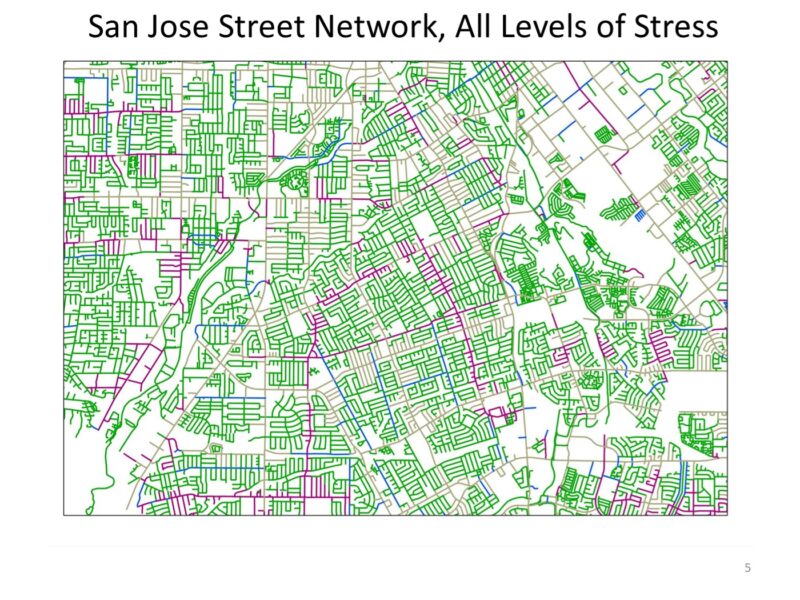
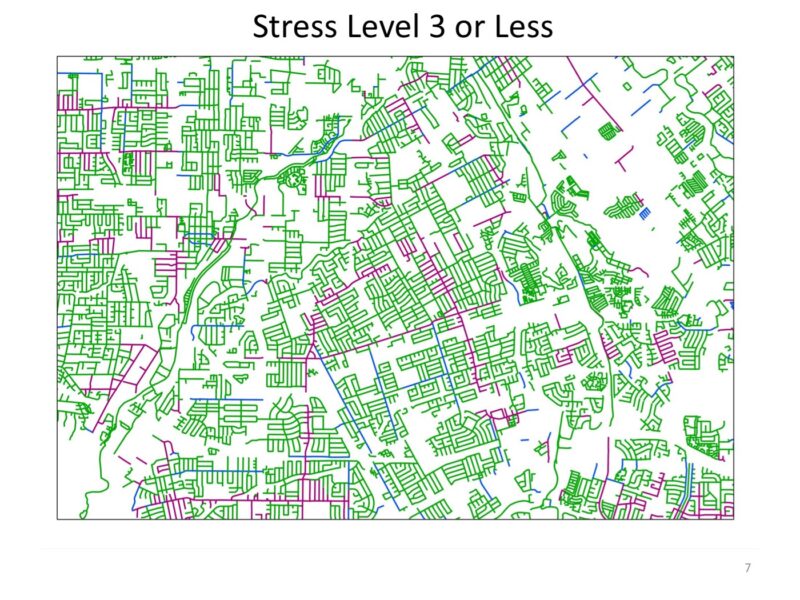
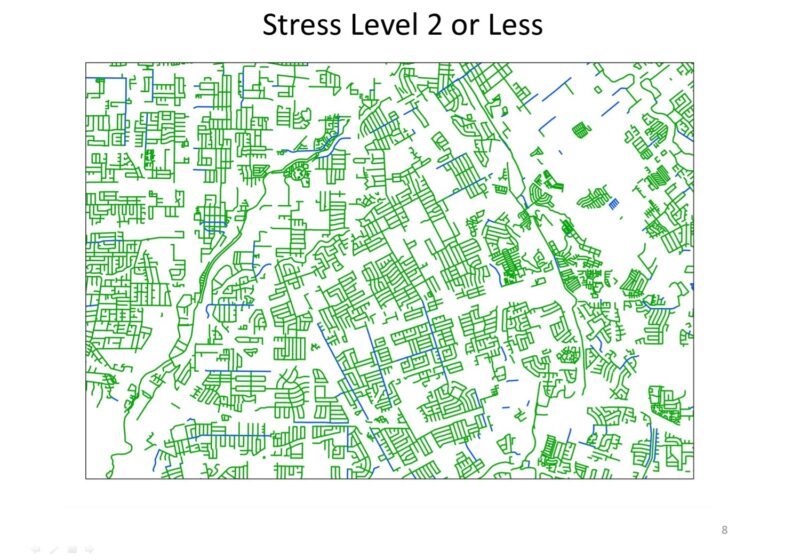
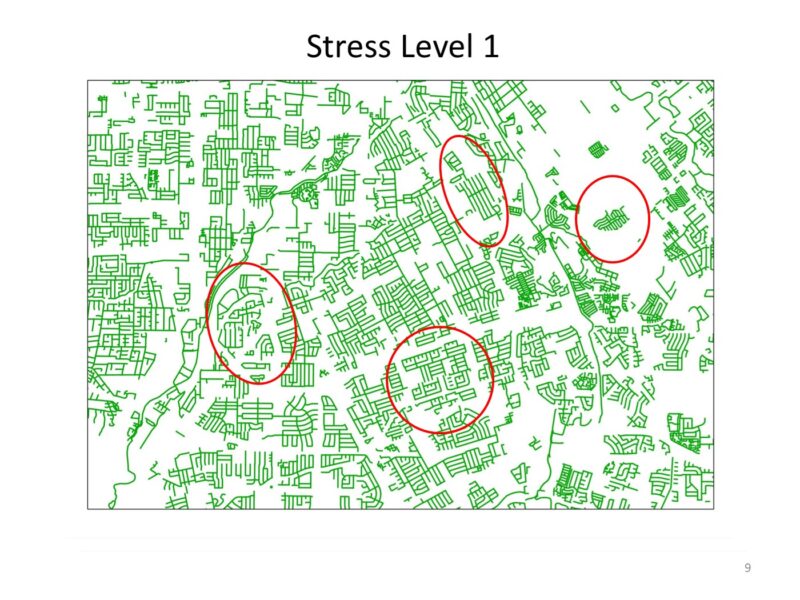
Winnipeg has lots of SROs (single room occupancy), how do we not lose those? My question is that in Edmonton did they tie the two together? Inclusionary zoning will be key here.
The City of Edmonton zoning bylaw accommodates SRO through Lodging House zoning classification: Bylaw 15953 November 13, 2012 17. Congregate Living means four or more individuals occupying Sleeping Units in a building where the occupants share access to facilities such as cooking, dining, laundry, or sanitary facilities. Typical Uses where Congregate Living is found include Fraternity and Sorority Housing, Group Homes, Limited Group Homes, and Lodging Houses. (See Edmonton Zoning bylaw, Section 76. Lodging Houses – https://www.edmonton.ca/documents/PDF/current_Zoning_Bylaw.pdf).
How is the city of Winnipeg moving towards expanding the definitional bounds of “single family”?
The Guidelines document is taking a step towards expanding what is permitted within the single family zoning districts by allowing two-unit uses (e.g. duplexes) within that zoning district. Currently, it is not permitted. The Preferred Location Criteria also takes a step by identifying where we would like to see other more denser housing forms (e.g. triplexes, fourplexes, townhomes and apartments) to locate within our Mature Communities. Overall, these Guidelines will help to encourage greater housing diversity.
Are you looking at different max lot coverages for different lot widths?
Lot coverages for multi-unit housing (greater than 5 units) will primarily depend on the type of street you are located on (i.e. local residential street versus a busier arterial street, like St. Mary’s Rd) and the type of neighbourhood you are located in (i.e. Area 1 or Area 2 neighbourhoods). We want to encourage more multi-unit housing options (e.g. apartments and townhouses) in a manner that can integrate well into the character of the neighbourhoods where they are built. Some neighbourhoods are better suited to accommodate very dense lot coverages, whereas other neighbourhoods less so. That is where the existing built-form character of those neighbourhoods matter.
For Jim: Your mayor has taken a strong lead on poverty reduction. Did his support of infill tie into poverty reduction efforts? If yes, any examples you can talk about?
There is a link to construction of permanent supportive and affordable housing and efforts to poverty reduction. About 3 years ago the City supported the establishment of the Community Development Company (CDC). The CDC has a mandate to provide affordable housing opportunities in Mature Neighbourhoods. CDC was provided with an inventory of City owned land, suitable for development at a significantly reduced rate. The CDC is acquiring and making investments in older and vacant properties in the MacCauley and Alberta Avenue communities currently. (https://edmontoncdc.org/). There is also an interfaith housing coalition that is dedicated to providing affordable housing in mature neighbourhoods (https://interfaithhousinginitiative.wordpress.com/). Habitat for Humanity continues to do good work in Edmonton mostly in suburban locations.
An organization in Edmonton, Homeward Trust, has a purpose of providing permanent supportive housing. They have recently embarked on the establishment of Bridge Housing to help people transition from the street to permanent supportive housing, who are willing to accept it. There are, as well, other organizations working closely with Homeward Trust to deliver supportive housing including Right at Home.
A lot of seniors housing was built in the 70s and 80s which doesn’t accommodate more recent realities like the use of scooters. Are there options to refit that housing to fill some of the needs for other people?
This project does not go into details on retrofitting existing homes to become more accessible. Rather, it encourages new development to be designed as accessible from the onset.
I was attending the City Centre Community Committee meeting last week, and councillors turned down a development that would have amalgamated lots to allow for a larger building that the developer said was necessary to support the cost of an elevator. Is this a consideration in the infill strategy development?
A building with an elevator typically requires more land and a larger building to make an elevator viable. The hope is with better clarity around massing expectations, the building community will have a better sense of where to invest, and planners and decision makers will have a better sense of the scale of development that is appropriate in any given context. Hopefully this leads to better decision making on where larger buildings can be located and ultimately, buildings with elevators for universal accessibility.
The information sessions were coordinated by Kate Kehler, Social Planning Council; Mel Marginet, Green Action Centre; Dianne Himbeault, CMHC; and Candance Karhut, f-BLOK Architecture.
If you support infill, be sure to reach out to your City Councillor and advocate for the adoption of the Infill Strategy!

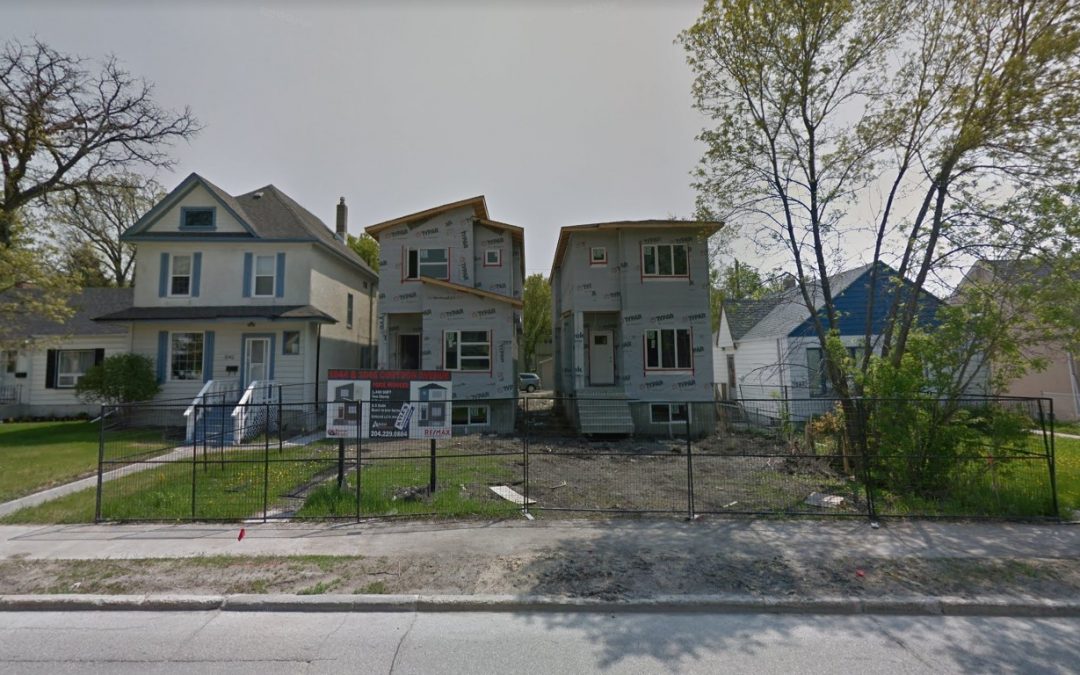


Recent Comments